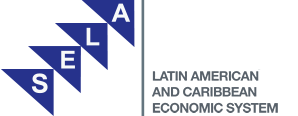BACKGROUND
The Permanent Secretariat of SELA has promoted the analysis of subregional integration processes through the preparation of different studies that deal with advances from the economic, social and institutional perspectives. Specifically, the Work Programmes for 2014 and 2015 included several studies that offered an overview of the status of the integration processes, as well as the main challenges and opportunities for a greater regional articulation, namely: “Assessment of the economic and cooperation relations between Central America, the Caribbean and Mexico,” “An analysis of trade flows between the CARICOM and Latin America” and studies that delve into the evolution of the integration mechanisms MERCOSUR, CAN, SICA and CARICOM.
In this context, a proposal is made to create indicators that measure the status and advances (performing updates over time) of subregional integration processes in Latin America and the Caribbean in a comprehensive manner, in the dimensions identified by the economic theory of integration. To that end, the Permanent Secretariat proposes the creation of an index where every dimension will be measured and will have a weight within a general indicator called SELA’s Integration Index for Latin America and the Caribbean.
For its part, the Secretariat for Central American Economic Integration (SIECA), aware of the regional request for good information and quality analyses on actions and achievements of the economic integration process, led by the Council of Ministers for Economic Integration (COMIECO), has developed research documents and studies on indicators that measure the degree of economic integration applied to Central America.
With the technical support of the Economic Commission for Latin America and the Caribbean (ECLAC), SIECA in 2015 reported significant advances in the construction of the Regional Central American Economic Integration Index (IRIEC), a tool designed to assist in the decision-making process at the regional level in the field of economic integration. The IRIEC aims to provide relevant information on the level of economic integration among Central American countries and to enhance the academic resources at the service of research and decision-making.
The concept of economic integration dates back to the 50s and early 60s, with the research made by Tinbergen and Balassa (JÖRG KÖNIG, 2014). In particular, the latter identified a series of stages or levels that characterize the integration process, namely: preferential trade agreements; free trade area; customs union; common market; economic and monetary unions; and political union. Each of these elements that define coordination or unification can and must be measured through the creation of indices or composite indicators that summarize the behaviour of a set of variables.
The construction of SELA’s Integration Index for Latin America and the Caribbean is expected to provide the possibility of assessing the aforementioned stages and the specific phase in which each subregional mechanism is located in this process. In addition, the indicator will help monitor on a regular basis the compliance with the agreements towards the explicit objectives of each agreement. Thus, the challenges and possibilities of the integration process in the region can be assessed. Furthermore, this initiative will provide a tool similar to that considered for the European Union (Jörg König and Renate Ohr, 2014 "EU-Index. Measuring European Economic Integration") or for the Asia-Pacific region (Chen Bo and Woo, Yuen Pau, 2008 "A Composite Index of Economic Integration in the Asia-Pacific Region"), required for the design and evaluation of policies.
This meeting, jointly organized by the Latin American and Caribbean Economic System (SELA) and the Secretariat for Central American Economic Integration (SIECA), will be attended by renowned international experts, who will present experiences and approaches to the treatment of the data. This will enrich the debate and offer a broader view of the methodological aspects related to the calculation of these indicators. Some of the areas that will be addressed during this meeting are as follows: intra-mechanism trade, foreign direct investment flows, supranational logistics and infrastructure, remittances, mobility of factors, harmonization of economic policies, institutional framework and performance of the major macroeconomic variables (GDP, inflation, unemployment, exchange rate, debt). Unlike other integration indicators that have been developed in others areas and regions, one of the fundamental contributions of SELA is the incorporation of environmental and cultural indicators in order to provide a more comprehensive vision of the sustainability and quality of the integration processes.








